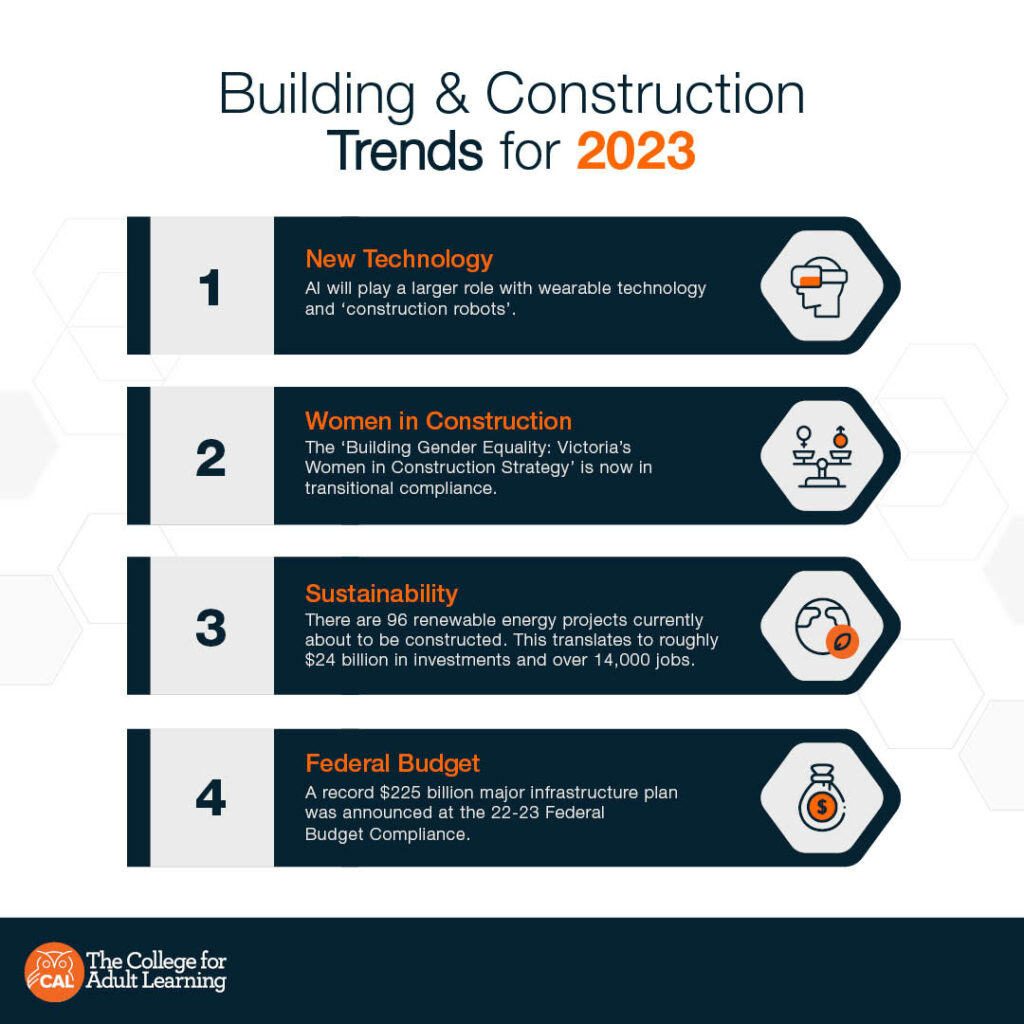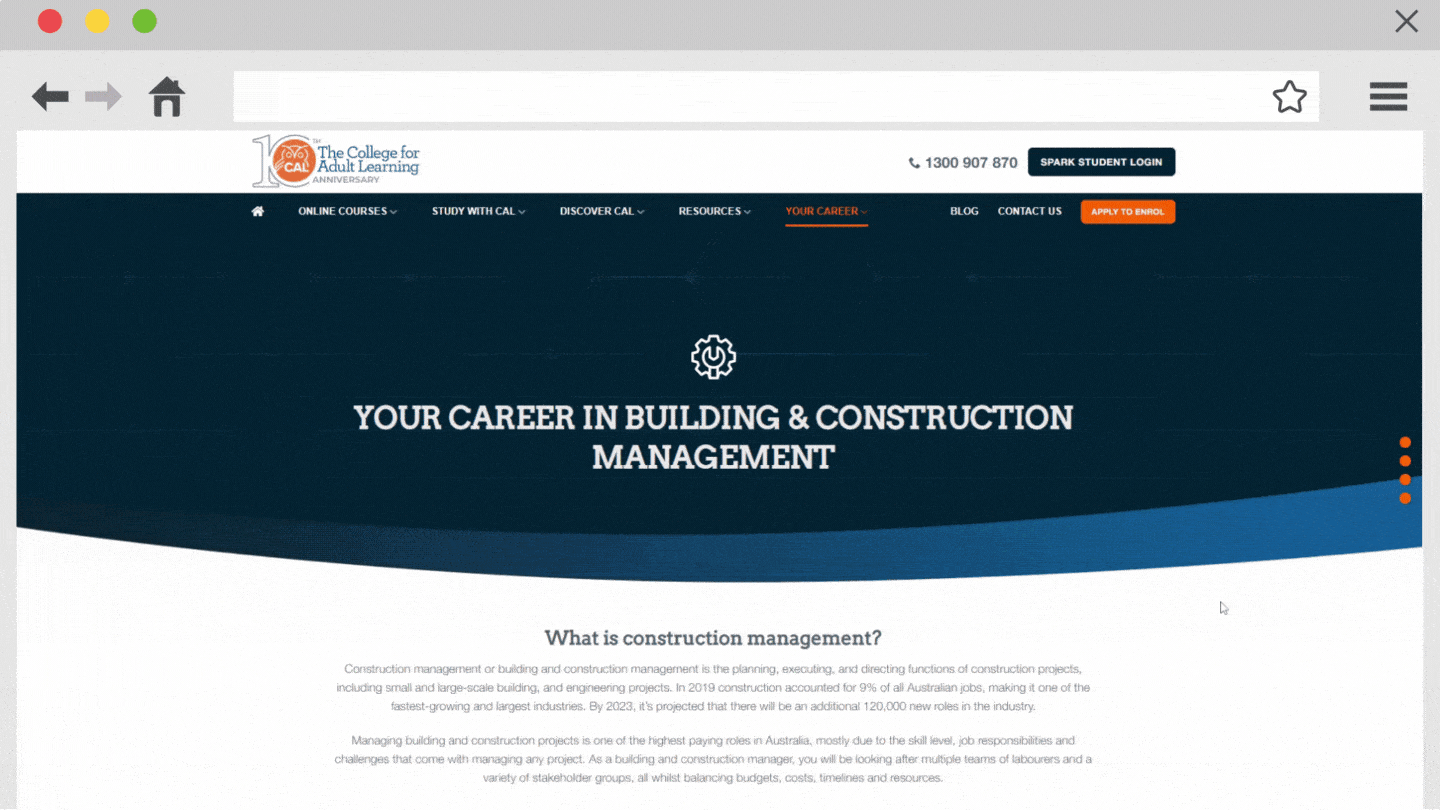
Constant construction trends developments mean the building and construction industry is always changing the ways they operate. In fact, the construction and building industry is one of the most adaptable and resilient industries in Australia. In 2023, we can start to look toward new and exciting infrastructure projects and trends on the horizon.
Construction Trends: Be prepared for new technology
Technology is an influential part of any construction project. Improved technology can assist with speed, efficiency, workload, and accuracy. Those who do not adapt to advancements can become uncompetitive in the marketplace. As a result, building and construction companies need to keep themselves armed with the best equipment for the job.
One example is 3D printing, which has been used in construction for a few years now. In the last few years, we saw a boom in the printing of materials like chipboard as an easy and cost-effective solution to production. Should this trend continue, it will impact the building and construction industry, in terms of where materials are sourced, the sustainability of materials used, as well as production cost. Investing in the machines that can create the product rather than having to buy the product itself may be a more cost-effective way to manufacture supplies.
Artificial Intelligence is another trend that we will see more of now and in the near future. It can be used in a multitude of ways to improve productivity, efficiency, and even safety. AI has started to become commonplace in large-scale construction and high-risk job sites, such as mines. Whether this is in the form of ‘construction robots’ that are here to help labour shortages around the world, or wearable AI technology that analyses risks in real-time.
The opportunities for expansion within technology in the construction industry are vast. Find out more about technology trends in construction in 2023.
Construction Trends: Women in Construction
Currently, only 13.6% of the construction industry is made up of women workers. The Victorian government is leading Australian policy by taking steps to increase women’s representation in building and construction. The ‘Building Gender Equality: Victoria’s Women in Construction Strategy 2019-2022’ is overseen by The Building Industry Consultative Council (BICC).
The BICC acts as a forum for dialogue between the government, employers, industry associations, and unions on significant issues affecting the building and construction industry. The Strategy was developed after extensive research and consultation with people in the construction industry, who are eager to contribute to the BICC’s initiative.
In implementing the strategy, the Victorian Government announced 2022 policy changes that require women to make up at least 3% of trade roles, 7% of non-trade positions, and 35% of management, supervisor, or specialist labour roles in government projects worth $20 million or more.
In 2023, the Victorian Government are enforcing a ‘transitional compliance’ period to get projects and companies up to speed with this. It is expected more women are to employed in the industry over the next year as companies prepare for these changes.
In the last two decades, the number of women in trades has doubled and this is tipped to continue to grow. There is currently a significant push from within the industry to focus on encouraging women to pursue a career in building and construction.
https://www.vic.gov.au/building-equality-policy

Sustainability is smart and unavoidable
An increase in climate action sentiment in Australia is forcing companies to reconsider their practices in the workplace. Consumers are also leading the way, demanding environmentally friendly buildings and sustainable building materials.
Here are three easy ways to ensure you remain sustainable in building and construction:
Better waste management
Waste management is an unavoidable part of the building and construction industry. The good news is there are many simple changes companies can make to construction sites that will add a green light to operations.
The first of these is to segregate waste by implementing a dedicated waste section on-site with clearly labelled and colour-coded bins, skips, or bags. Training staff and contractors to use the system is the next step. A team that knows how to manage waste effectively will save costs for those projects that are currently hiring a specialised team to do this task.
Another waste management practice that has twofold positive effects is deconstructing instead of demolishing. Demolition is a messy, polluting procedure that has far less long-term gain than precise deconstruction. Deconstruction allows for a safe environment and a high potential to reuse or sell recycled materials in the process.
Renewable and efficient energy use
Solar power will continue to be in demand as clients look to incorporate this into new or existing builds. There have been 3.36 million PV (solar power) installations in Australia. These have become a rising trend in renewable energy that will only become more commonplace. RMIT and the University of Melbourne have partnered with a manufacturing group to create a solar panel upcycling plant funded by a federal government grant.
Renewable energy will not just be propelling the industry forward in innovation, but in job growth, too. In Australia, there are 96 renewable energy projects currently being constructed, or about to be. This translates to roughly $24 billion in investments and over 14,000 jobs. As renewable energy options in Australia grow, so will the career opportunities.
Source sustainable materials
Sourcing sustainable materials is an easy way to keep a construction site on an ethical footing for only a small increase in cost. Be sure to research and support businesses that are not causing deforestation and are reducing emissions. As mentioned above, reusing materials is another effective way to resource sustainably.
The good news Federal budget
In the October 22-23 budget, the Federal government announced new funds allocated to transport infrastructure projects across the country. It also announced a record $225 billion major infrastructure plan for the next 2 years, securing further projects and jobs.
The $9.6billion package towards transport infrastructure includes important funding towards projects such as:
- $300 million for Western Sydney Roads Package and $500 million for the High-Speed Rail Authority
- $2.2 billion for the Suburban Rail Link in Victoria
- $586.4 million of additional funding for a major upgrade of the Bruce Highway to widen a 13-kilometre stretch through Brisbane’s outer northern suburbs
- $1.5 billion for upgrading important freight highways, sealing the Tanami, and upgrading Central Arnhem Road, as well as the Dukes, Stuart and Augusta highways in SA
- $540 million to upgrade Tasmania’s important road corridors, including the Bass Highway, the Tasman Highway and the East and West Tamar Highways.
- $125 million funding to help build an electric bus network for Perth
These budget allocations have opened up a wide range of opportunities in building and construction, whether you’re after an on-the-tools position or a managerial role.
https://investment.infrastructure.gov.au/about/budget.aspx
Download our FREE 'Your Career in Building and Construction Management' Guide
Find the latest information in our eBook about a career in construction management, including current job opportunities, skills you need, salary information and more.
Job Growth for Construction Roles
Following on from budget announcements and commitments, job growth in building and construction continues to be promising. Over the next 5 years, the industry itself is set to grow by 5.8%, and employment in the industry grew by 11.8% in the last year alone.
Some of the building and construction jobs with the highest growth are:
- Construction manager, with an expected job growth of 10.2%
- Plumbers, with an expected job growth of 8.6%
- Architectural, Building & Surveying Technicians, with an expected job growth of 11.9%
https://labourmarketinsights.gov.au/industries/industry-details?industryCode=E#overview
What can you take from these 2023 construction trends?
There is a strong job growth projected for building and construction in 2023, as investments into renewable projects, transport infrastructure, and women in construction opportunities continue to grow.
We are likely to see more innovative ways to work and new design elements. Whether it’s new ways to incorporate materials or the importance of sustainability within the industry, these changes are optimistic as we move forward. For women looking to get into the industry, the time has never been better with a continued focus on encouraging diversity.
With an emphasis still on attracting young people into the industry, now is an exciting time to be a young Australian who is interested in building and construction. Likewise, the need for project managers and good communicators makes this industry a smart choice for the career-savvy professional looking to make a change.
An online Diploma of Project Management (Specialising in Construction) (BSB50820) is the best place to start, designed for those wanting to move into senior construction project management positions. Once you’re there, an online Diploma of Building & Construction (Management) (CPC50320) will set you up to pursue opportunities in managing multi-million-dollar construction projects, running your own successful trade business, and more.
Your Career in Construction Management
Do you want to learn more about construction management skills employees demand, the latest emerging job roles and salaries, and recent industry insights?
Discover your career in construction management.
CONSTRUCTION MANAGEMENT CAREER PAGE
1ABS, 2021.






